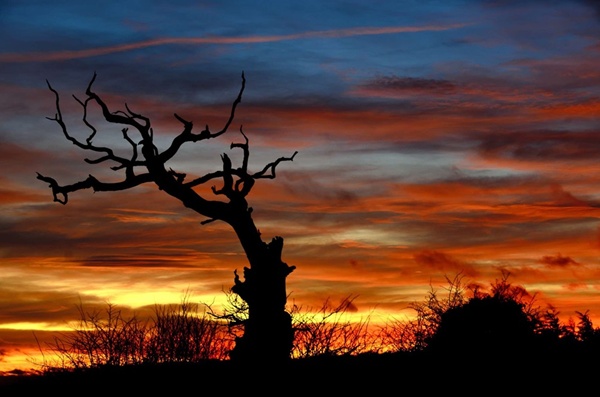The Sky This Week from December 20 to 29 – Astronomy Magazine
Winter Solstice 2014
The winter solstice, which occurs when Earth’s North Pole tilts farthest away from the Sun, marks the start of Northern Hemisphere winter. The photographer captured this beautiful image just after sunset on the December 21, 2014, winter solstice.
Jon Bunting/Flickr
Head outside in the early evening and you can see the Big Dipper scraping the northern horizon. For latitudes north of about 40°, this conspicuous asterism never rises or sets (“circumpolar” in astronomical parlance), though December evenings find it at its lowest ebb. This means that the constellation on the opposite side of the North Celestial Pole, the familiar W-shaped Cassiopeia, currently rides highest in the sky.
Saturday, December 21
Earth’s winter solstice occurs at 11:19 p.m. EST. At that moment, the Sun reaches its farthest point south in the sky. The solstice marks the official beginning of winter in the Northern Hemisphere, and tonight has more hours of darkness than any other. From mid-northern latitudes, however, the earliest sunset occurred about two weeks ago and the latest sunrise won’t happen until early January.
If you’re game for a quick evening challenge, try to spot Neptune through binoculars. The distant planet lies halfway to the zenith in the south-southwest near the end of evening twilight and doesn’t set until nearly 11 p.m. local time. The magnitude 7.9 world appears against the backdrop of Aquarius, 1.3° west-southwest of the 4th-magnitude star Phi (φ) Aquarii. You’ll need binoculars to spy Neptune and a telescope to see its blue-gray disk, which spans 2.3″.
Sunday, December 22
The Ursid meteor shower peaks tonight. The shower’s radiant — the point from which the meteors appear to originate — lies in the constellation Ursa Minor, near the bowl of the Little Dipper. The radiant is visible in the north all night, but it climbs higher as dawn approaches. And the waning crescent Moon won’t interfere much even after it rises around 4:30 a.m. local time tomorrow morning. Observers with clear skies typically see 5 to 10 Ursid meteors per hour at the peak, but astronomers predict a possible enhancement this year that could briefly double or triple the normal rate.
Ruddy Mars grows more prominent before dawn with each passing week. The Red Planet now rises by 4:30 a.m. local time and climbs 20° above the southeastern horizon an hour before sunrise. Mars glows at magnitude 1.6, which is a full magnitude brighter than any of the background stars belonging to its host constellation, Libra the Scales. But there is a brighter object lurking in Libra: a waning crescent Moon. Luna stands 9° above Mars this morning; tomorrow morning, it will be 6° to the planet’s lower left. Unfortunately, a telescope doesn’t add much to the view of Mars, revealing a bland disk just 4″ across.
Monday, December 23
Uranus reached opposition and peak visibility nearly two months ago, but it remains a tempting target in December. The outer planet appears in the southeastern sky after darkness falls and climbs highest in the south around 8 p.m. local time. The magnitude 5.7 world lies in southwestern Aries the Ram, near that constellation’s border with Pisces the Fish and Cetus the Whale. Although Uranus shines brightly enough to glimpse with the naked eye from a dark site, binoculars will help your search immensely. The closest guide star is magnitude 4.4 Xi1 (ξ1) Ceti, which lies 4° to the southeast. A telescope reveals Uranus’ disk, which spans 3.7″ and shows a distinct blue-green hue.
Tuesday, December 24
A lone bright star now hangs low in the south-southwest during early evening. First-magnitude Fomalhaut — often called “the Solitary One” — belongs to the constellation Piscis Austrinus the Southern Fish. From mid-northern latitudes, it appears below the Great Square of Pegasus and about 20° above the horizon. How solitary is Fomalhaut? The nearest 1st-magnitude star to it, Achernar at the southern end of Eridanus the River, lies some 40° away.
Wednesday, December 25
This year provides a stunning “Christmas Star” for early evening viewers. Head outside during the deepening twilight and look to the southwest for the brilliant light of Venus. The brightest planet shines at magnitude –3.9 and shows up nicely from half an hour past sundown until it sets after 7 p.m. local time. A telescope reveals the planet’s 13″-diameter disk, which appears 84 percent lit.






